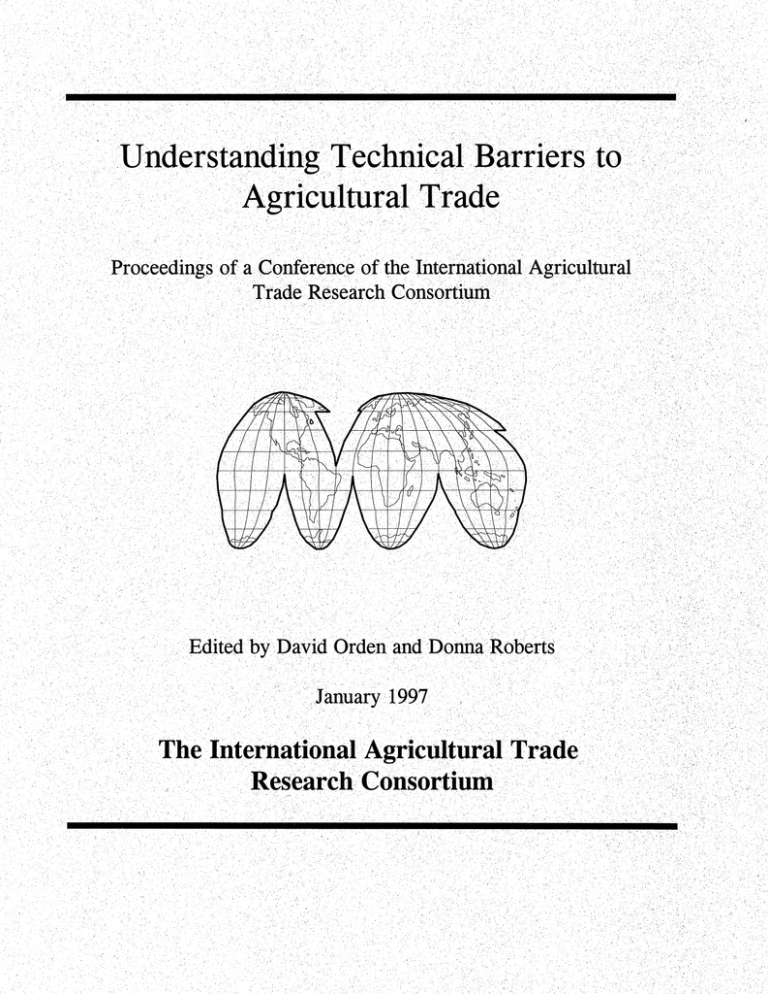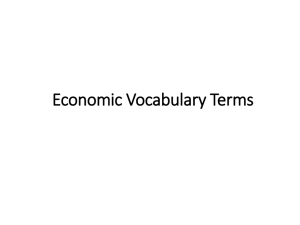P - ;-i I -- : ~ .~
advertisement

Understanding Technical Barriers to
Aricultural Trade
Proceedings of aTrade
Conference of the International Agricultural
Research Consortium
Edited by David Orden and Donna Roberts
January 1997.
The International Agricultural Trade
Research Consortium
-;-i ~-~I-- :~.~
r
r
.+
.
-
r
J
l
-
4
f
v
V.
No"
..
..
z .':
-
..
f.,.
.
r..
F
.
+,
-
_
(.
-
.
,.
.,
.
,
-
'
-
,-..a
rr
r
i
.
v
f
r
i.
v
r:
...-
.,
r
I
rr
..
_
-
:..r
.r
(-
_
..
-
-
-
_
j
:1
rr
.
-
-
..
-.
:.
i.
,
.
-
-
_
..
"r
i
'f
,r
,.
,
4'
-
nn
-t
-
r
'i
-
-
1
_)
J{
.
-
-
_
..
,:
-
r
r
:.
-
.,
"
Understanding Technical Barriers to Agricultural Trade
Proceedings of a Conference of the International Agricultural
Trade Research Consortium
Edited by David Orden and Donna Roberts
January 1997
Orden, David and Donna Roberts, editors (1997).
Understanding Technical Barriers to Agricultural Trade. St.
Paul, Minnesota: University of Minnesota, Department of
Applied Economics, International Agricultural Trade
Research Consortium.
Additional copies available from the
International Agricultural Trade Research Consortium
Preface
The International Agricultural Trade Research Consortium [IATRC] is a group of 160
economists from 16 countries who are interested in fostering research related to
international trade of agricultural products and commodities and providing a forum for the
exchange of ideas. Each winter the IATRC sponsors a "Theme Day" conference on a topic
related to trade and trade policy.
The activities of the IATRC are made possible by financial support from the Economic
Research Service and the Foreign Agricultural Service of the US Department of
Agriculture [USDA], and from Agriculture and Agri-Food Canada. The theme day in
December 1995, from which the papers are reported in this proceedings, was also
supported by grants from the University of Arizona and the Cooperative State Research,
Education and Extension Service, USDA.
The editors acknowledge the assistance of Laura Bipes of the University of Minnesota
in arranging the conference. We also recognize the contributions of the discussants and
other participants whose comments are reflected in the final versions of the papers.
Suzanne Thornsbury of Virginia Polytechnic Institute and State University took
responsibility for the technical editing, with assistance from Alisa Livenspurger. The
manuscript was prepared for publication by Jenifer Kittle. Our sincere thanks are
expressed to each of these individuals for their contributions.
A complete list of past IATRC conferences and related publications, including
proceedings, commissioned papers and working papers, is available from Laura Bipes,
Administrative Director, Department of Applied Economics, University of Minnesota, St.
Paul, MN 55108. Information about the IATRC is also available at
http://www.umn.edu/iatrc.
Table of Contents
................
Preface ...................
List of Contributors ....................................
.........
Foreword
David Orden and Donna Roberts ..................................
i
v
vii
Overview
1.
Nontariff Agricultural Trade Barriers Revisited
Jimmye S. Hillman .....................................
.........
1
2.
The Intersection of Law and Trade in the WTO System: Economics and the Transition
to a Hard Law System
33
FrederickM.Abbott ..........................................
3.
The Political Economy of Administered Decisions: What We Might Hope For and What
We Can Expect
49
.........
Gordon Tullock ......................................
Institutional Perspectives
4.
Implementation of the WTO's Agreement on Sanitary and Phytosanitary Measures: The
US Perspective
63
.........
........
Alex Thiermann ..............................
5.
Impact of WTO on CODEX Alimentarius and Its Implications for World Trade
RichardJ.Dawson...............................................
69
Implications of the WTO Agreement on Sanitary and Phytosanitary Measures
GretchenH.Stanton...........................................
75
6.
Political Economy
7.
Technical Measures for Meat and Other Products in Pacific Basin Countries
R.WM Johnson..............................................79
8.
The Political Economy of US Import Restrictions on Nursery Stock and Ornamental
Plants in Growing Media
99
EduardoRomano andDavid Orden .................................
111
9.
Determinants of Technical Barriers to Trade: The Case of US Phytosanitary Restrictions
on Mexican Avocados, 1972-1995
DonnaRoberts and David Orden...................................117
Related Administrative Processes
10. End-Use Certificates for Wheat: Trade-Distorting Administrative Barriers?
Richard Gray and Donald F. Buckingham.............................161
11. US International Trade Commission Decisions Affecting Agricultural Products
Cathy L. Jabara...............................................181
12. National Administered Protection Agencies: Their Role in the Post-Uruguay Round
World
KarlD. Meilke andRakhal Sarker..................................195
13. ITC Injury Determination and the Abuse of Antidumping Law: Evidence from the
United States Manufacturing Industries
227
RobertW Staiger andFrankA. Wolak..............................
Modeling Technical-Barrier Decisions and Impacts
14. Uncertainty Aversion and Technical Barriers to Trade: An Australian Example
DonaldMacLaren.............................................
255
15. Sanitary and Phytosanitary Trade Barriers and Empirical Trade Modeling
DanielA. Sumner and Hyunok Lee ..................................
iv
273
List of Contributors
1. Frederick M. Abbott, Professor of Law
Chicago-Kent College of Law
Illinois Institute for Technology
565 West Adams St.
Chicago, IL 60661
8.
Hyunok Lee, Res. Economist
University of California-Davis
Dept. of Agric. & Res. Econ.
Voorhies Hall
Davis, CA 95616-8512
2. Donald E. Buckingham, Assoc. Professor
Center for Studies in Agriculture, Law and
the Environment
University of Saskatchewan
Saskatoon SK S7N 5A8
CANADA
9.
Donald MacLaren, Professor
University of Melbourne
Department of Economics
Parkville, Victoria 3052
AUSTRALIA
3. Richard J. Dawson, Sr. Technical Advisor
Food Quality, Safety, Nutrition & CODEX
FAO/RAP
Maliwan Mansion, Phra Atit Road
Bangkok, THAILAND
10.
Karl D. Meilke, Professor
University of Guelph
Dept. of Agricultural Econ.
Guelph, Ontario N1 J 1Si
CANADA
4. Richard Gray, Professor
University of Saskatchewan
Dept. of Agricultural Economics
Saskatoon SK S7N 5A8
CANADA
11.
David Orden, Professor
Virginia Tech
Dept. of Agri. & Applied Econ.
Hutcheson Hall
Blacksburg, VA 24061
5. Jimmye S. Hillman, Professor
University of Arizona
Dept. of Agricultural & Resource Economics
Tucson, AZ 85721
12.
Donna Roberts, USDA/ERS
US Mission to the WTO
Rue de Pregny, 11
1292 Chambesy
Geneva, SWITZERLAND
6. Cathy L. Jabara, Division Chief
US International Trade Commission
Agriculture & Forest Products Division
500 E. St., SW
Washington, DC 20436
13.
Eduardo Romano, Res. Asst.
Virginia Tech
Dept. of Agric.. & Applied Econ.
Hutcheson Hall
Blacksburg, VA 24061
7. R. W. M. Johnson, Economist
Ministry of Agriculture & Fisheries
Box 2526
Wellington
NEW ZEALAND
14.
Rakhal Sarker, Assistant Professor
University of Guelph
Dept. of Agricultural Economics
Guelph, Ontario N1J 1S1
CANADA
15. Robert W. Staiger, Professor
The University of Wisconsin
Dept. of Economics
1180 Observatory Dr.
Madison, WI 53706
16. Gretchen H. Stanton, Counselor
World Trade Organization
Agriculture & Commodities Division
154 Rue de Lausanne
Geneva 11211, SWITZERLAND
17. Daniel A. Sumner, Frank H Buck, Jr. Professor
University of California-Davis
Dept. of Agricultural and Resource Economics
Voorhies Hall
Davis, CA 95616-8512
18. Alex Thiermann, Senior Trade Coordinator
Animal and Plant Health Inspection Service
USDA
40 Boulevard Du Regent B3
1000 Brussels, BELGIUM
19. Gordon Tullock, Karl Eller Professor
University of Arizona
Dept. of Economics and Political Science
McClelland Hall
Tucson, AZ 85721
20. Frank A. Wolak, Professor
Stanford University
Dept. of Economics
Stanford, CA 94305-6072
vi
Foreword
Technical barriers affecting agricultural trade are emerging at the center of international
commercial disputes with increased frequency. These barriers include sanitary and
phytosanitary [SPS] regulations and other measures which establish rules for quality,
packaging, labeling, standards of identity, and conformity assessment. Their new prominence
is due in part to growing worldwide demand for enhanced food safety, and for an
environment that is protected from pests and diseases. Expanded international trade in
processed food products, on which technical regulations are often applied, also contributes
to their heightened visibility. Moreover, the recent Agreement on Agriculture of the World
Trade Organization [WTO], has increased the relative, and perhaps the absolute, importance
of technical barriers by reducing tariffs and disciplining nontariff quantitative limits on
agricultural trade.
New WTO Agreements on SPS measures and other technical barriers, together with
strengthened WTO dispute settlement procedures, also raise prospects for resolution of some
of the long-standing and some of the newly-emerging conflicts over various technical trade
restrictions. Still, it is widely recognized that there is enormous potential for, and perhaps
widespread misuse of, technical measures as nontransparent obstacles to trade, even when the
broad desirability of lowering risks to health and safety is acknowledged, and despite the new
(and as yet untested) international rules. Indeed, some use the term "technical trade barriers"
only when the stated or original purpose of national laws, regulations and standards to
provide a public good has been subverted by those with a vested interest in limiting
competition.
Can there be progress against misuse of technical barriers to agricultural trade while
protecting legitimate health and environmental concerns? This volume comprises the
proceedings of a conference in which the issues raised by this question were addressed. The
conference was sponsored by the International Agricultural Trade Research Consortium
[IATRC], with financial support from the University of Arizona and from a competitive grant
received through the Cooperative State Research, Education and Extension Service, US
Department of Agriculture. Held in Tucson in December 1995, the conference was convened
in tribute to Jimmye Hillman, professor emeritus at the University of Arizona, former the head
of its Department of Agricultural Economics, and a founding member of the IATRC. Much
of Jimmye Hillman's professional work, including his books Nontariff Agricultural Trade
Barriers (1978) and Technical Barriers to Agricultural Trade (1991), have served to focus
attention on the issues considered by the conference long before they achieved their current
prominence.
The proceedings are divided into five sections. The first section provides a broad
overview of the issues. In his lead paper, Hillman describes the efforts to classify the many
types of nontariff trade barriers that have brought economists to focus on restrictions
"imposed on foreign imports for health, safety or related reasons." He worries, that another
"catch-all" term--environmental restrictions--might result in the discourse again being
ensnared in an unproductive "amorphous terminology." Hillman notes that the use of
"mandated science" to make regulatory decisions strains the scientific capacity for impartial
vii
inquiry. Pointing to the unavoidable administrative aspect of regulations on specific technical
questions, he queries rhetorically whether, if science is incapable of injecting discipline into
such debates, it would be better to "leave such questions to politicians and trade
administrators?" Rejecting that option, he is left with the need for coordinated international
commitments, however imperfect, to determine criteria for technical trade barriers and to
resolve disputes that arise. Hillman notes that for nontariff issues, there will be a
"considerable volume of specific and definitive research material based on countrycommodity-technical phenomena." The challenge he poses to the IATRC is to assist the
cause of freer international trade by "adducing the facts and intent of agricultural protection
which uses technical criteria as a rationale."
In a second overview paper, Frederick Abbott carries forward the theme of administered
protection. He describes the movement from "soft law" under the GATT, which relied on
a flexible process of political bargaining, to a system of"hard law" in the WTO, with greater
reliance on fixed rules. The new Dispute Settlement Understanding, which applies to all of
the multilateral trade agreements, epitomizes the difference in approach. Under the GATT,
a consensus of the members, including the member against whom a complaint had been filed,
was required for a dispute settlement panel report to be binding. In contrast, the new
procedures make the adoption of a panel report automatic, except in the unlikely event of a
consensus vote againstit. Abbott attributes the shift of emphasis toward hard law to the
breakdown of US-European hegemony in international affairs. The presumption is that a
system of hard law will reduce transactions costs more effectively than soft law in a lesshegemoneous multilateral world. Abbott asserts that some caveats are in order. Some of the
new laws may not favor liberalized trade, so their enforcement will not open trade
opportunities. Moreover, should strict enforcement of hard law become too onerous,
countries may become increasingly reluctant to make new commitments to eliminating trade
restrictions. Abbott cites antidumping laws as archetypal administered trade barriers. The
WTO, he observes, allows for "more than one permissible interpretation," so that rules
governing antidumping measures may be "adjusted to suit individual members." Abbott
concludes that if hard law reforms were to reduce the frequency of protection provided to
powerful domestic political constituencies among the member countries, the resistance to
such reforms would intensify.
In the third overview paper, Gordon Tullock, the conference keynote speaker, elaborates
on the political economy of rent seeking. Briefly acknowledging that technical trade barriers
have "the odd characteristic that it is not certain that [they] are unwise," Tullock decries the
costs society pays to satisfy the demands of special interests. He then poses the question of
why the payments that special interests appear to make (lobbying expenses, campaign
contributions, and the like) seem so small compared to the benefits they obtain. He posits
that an increasingly inelastic supply of protection as its level rises is one reason, and the
uncertainty of the outcomes, with many losers in the protection-seeking lottery, is another.
More fundamental, in Tullock' s view, is that politicians help deliver benefits to each other's
organized constituents and repay one-another by their mutual support. The cost of this
logrolling is high to the average voter, but political ignorance and a prisoner's dilemma
perpetuate the system. Tullock's paper was given in honor of Jimmye Hillman, who he
viii
credits with speaking out against costly distortionary polices throughout his career, and in
spite of potentially adverse consequences.
The second section of the proceedings provides perspectives on the issues raised by
technical trade barriers from three individuals who are on the front lines of regulatory decision
making and negotiations. The tone of the presentations changes noticeably from Tullock, as
representatives from the US Animal and Plant Health Inspection Service [APHIS], the
FAO/WHO Codex Alimentarius and the WTO present optimistic views on the efforts of their
institutions to develop appropriate standards for technical barriers to agricultural trade. Alex
Thiermann contrasts a regulatory paradigm characterized by a "zero-risk approach" with one
that concentrates on "facilitating trade." He asserts that the latter is the paradigm of the
future, and that success of the science-based WTO SPS principles will depend on how quickly
the existing paradigm changes. He outlines steps APHIS is taking to comply with the WTO
principles and to increase understanding of the new rules by the agency's stakeholders.
In the second paper from a policy maker's perspective, Richard Dawson describes the role
of CODEX in establishing international standards for food-safety criteria and procedures to
facilitate the harmonization of standards among countries. He is optimistic that Codex
standards and practice will become the benchmark against which national regulations are
evaluated, and that this will contribute to assurance of safe and nutritious food-delivery
systems.
In the paper on the WTO, Gretchen Stanton briefly describes the origins of the SPS
agreement, which she asserts "clarifies both the rights of governments to take health
protective actions and the conditions which must be met to ensure that these are not
unjustified restrictions on trade." Stanton notes that ultimate decisions about what constitutes
acceptable risks rests with sovereign governments. She points out that there were "virtually
no" SPS trade disputes settled through the GATT in its 47 years, and that the new SPS
agreement and dispute settlement understanding may provide more effective disputeresolution mechanisms. Despite this hope, the lack of GATT cases, taken together with the
evidence presented in this volume (and elsewhere) about on-going SPS disputes (including
Stanton's accounts of the conflicts leading to negotiation of the SPS agreement) underscore
the perception that multilateral trade rules have not yet effectively induced a system of
technical regulations that fully allows safe and fair trade, as the three speakers envision
bringing to fruition. Implementation of the SPS agreement, Thiermann observes, will be
"much harder than its drafting."
"Much harder than its drafting." The third section of the proceedings turns to three case
studies of SPS disputes. In the first paper, Robin Johnson describes the diversity among the
SPS and other technical standards that have to be met by New Zealand meat exports to
Pacific Basin countries. He argues that the most important feature of these standards is the
lack of uniformity, and views establishment of a more consistent set of rules as a principal
objective of the Uruguay Round GATT agreements. The real tests, he argues, will come in
case-by-case comparisons, and often the outcomes will depend on what is interpreted as
"acceptable risk." Johnson briefly summarizes four cases of decision making about SPS
barriers. In two cases (imports of New Zealand apples into Japan and Canadian salmon into
ix
New Zealand) bilateral discussions led to mutual decisions that trade did not pose an
unacceptable risk level, and restrictions were relaxed. In two other cases (imports of New
Zealand apples into Australia and of modified genetic material into New Zealand) the decision
went against opening a trade opportunity. In these latter cases, Johnson judges the importing
country to have concluded that the risks or consequences were too great--even if the chances
of occurrence were considered low, trade was judged unacceptable because of these potential
damaging consequences. Johnson concludes that there is need for much more international
dialogue to achieve consensus on what is meant by acceptable risk, taking into account the
economic benefits of trade, the degree of risk, and the possibilities for risk management.
The next two case studies bring an explicit political economy perspective to bear on
decision making about technical trade barriers. These studies demonstrate how difficult
reaching a decision to lower technical barriers can become. Eduardo Romano and David
Orden trace the history of the dispute over importation into the United States of nursery stock
and ornamental plants in sterile growing media. In the early 1980s, APHIS approved imports
of six genera if they were produced under specified phytosanitary conditions. Requests for
importation of another sixty genera potentially had a "major" economic impact (more than
$100 million according to the Office of Management and Budget), and were opposed by the
domestic industry. Pest risk assessments by APHIS appeared to justify a rule allowing many
of the genera to be imported, but in 1983 the regulatory process ceased. When work on the
nursery stock case was resumed three years later, efforts to progress toward new regulations
met with limited success. In 1995, thirteen years after its first rule to allow imports of nursery
stock in growing media, APHIS published a second rule allowing an additional four genera
to be imported. Even this rule, affecting imports with market value of less than $5 million,
remains subject to a court challenge by domestic producers.
The second detailed case study of phytosanitary decision making, by Donna Roberts and
David Orden, traces the longstanding dispute between Mexico and the United States over the
US phytosanitary regulations that have prohibited imports of Mexican avocados. During the
1970s, USDA scientists recommended that avocado imports from two Mexican states be
allowed entry under certain specified conditions. The domestic US industry, which benefits
from favorable price differentials resulting from the import ban and which has high sunk costs,
opposed any change in the regulations. The industry's views on the matter prevailed, and the
import ban remained in place. After a long delay, negotiations for the North American Free
Trade Agreement [NAFTA] provided the impetus to another reevaluation of the avocado
quarantine, starting in 1990. Despite industry objections, in July 1995 the USDA published
a proposed rule to amend the quarantine to allow imports into the northeastern United States
from Michoacan, Mexico during the months of November to February under stringent
conditions for insect population monitoring, cultural practices, and inspections. If it were
implemented, the proposed rule would be a landmark in the avocado dispute, and an
important example in which international negotiations led to easing of technical restrictions
on agricultural trade. However, more than a year after the proposed rule was issued, no final
rule has been published and movement of avocados between Mexico and the US mainland
remains prohibited.
x
The fourth section of the proceedings turns from studies of specific instances of decision
making about technical trade barriers to analysis of other forms of case-by-case administered
trade policy determination. In the first paper, Richard Gray and Donald Buckingham describe
the end use certificates [EUCs] required for movement of wheat between the United States
and Canada. EUCs are a trade-distorting administrative barrier that increases transaction and
handling costs. Gray and Buckingham find the Canadian EUC regulations to be the most
onerous, but accept the argument that the regulations help protect the reputation of Canada
as an exporter of grain with consistently high quality. The US EUCs prevent the subsidized
re-export of Canadian grain under the Export Enhancement Program but, ironically, also help
the Canadian Wheat Board maintain its monopoly power. Simulation results suggest that
Canadian producers would be worse off if the US EUCs were eliminated, leading Gray and
Buckingham to conclude that the certificates "may not create more than a token opposition
from Canadian officials."
The remaining papers in the fourth section of the proceedings focus on what Abbott
characterized
as "archetypal" administered trade barriers--antidumping [AD] and
countervailing duty [CVD] cases. Cathy Jabara describes the process by which the US
International Trade Commission [ITC] assesses whether domestic firms have been materially
damaged in AD and CVD cases. She provides a list of ten ITC injury investigations for
agricultural and forest products since 1989, and points out that while these investigations can
have important effects on trade of specific commodities, they have had "an almost negligible
effect on overall US imports."
Jabara also lists six ITC investigations involving
determination of whether imports interfered with the operation of domestic agricultural
support programs (Section 22 investigations). She concedes that the ITC investigations have
been "subject to some criticism" for being protective of domestic industries, but argues that
the cost of bringing a complaint eliminates "absolutely frivolous cases." Jabara also defends
the ITC hearing process for allowing trade policy changes to be "debated in the open."
In the second paper on AD and CVD cases, Karl Meilke and Rakhal Sarker concur that
ITC rulings generally affect less than one percent of US imports but argue that this measure
under-represents the consequences of the AD and CVD procedures because less formal
outcomes also "involve import harassment and import protection." A key facet of the Meilke
and Sarker paper is to recommend that the WTO become the primary judicial body for
handling CVD disputes, while national "administered protection agencies" be given a
redefined mandate to publicize the costs and benefits of various trade policies (a transparency
mission), to investigate trade practices, and as an advocate for domestic industries in the
international proceedings. The Meilke-Sarker recommendations rests on descriptions of the
basic economic impacts of export and production subsidies that countervailing duties are
designed to offset, and of other aspects of assessing the appropriate duty levels in cases where
they are justified (for example, determination of the similar domestic products, or upstream
effects). Their recommendations also rests on recognition that real world cases are "messy."
To illustrate the range of issues that arise, Meilke and Sarker review the evolution of, and the
arguments surrounding, four specific cases (the US CVD cases against Canadian softwood
lumber and hogs and pork, the US section 22 case against Canadian durum wheat, and the
Canadian CVD case against US corn). Each of these cases highlights reasons that Meilke and
xi
Sarker argue administration of CVD protection should be moved from national to
international forums.
In a final paper on antidumping duties, Robert Staiger and Frank Wolak pursue the
question of whether US domestic industries abuse the ITC's administrative procedures.
Using a sophisticated econometric model of imports, domestic production and case filing
status, they distinguish between unobservable "process filers" and "outcome filers." Process
filers seek the protection that arises simply from initiating an antidumping action, whether
their case has merit or not. Outcome filers choose to file based on a reasonable expectation
that they might be granted final duties. The distinction is important because preliminary
evaluations favor the domestic industry in a high percentage of cases, so the proceedings
almost always go forward until further evaluation of the merits of each case has been made.
Staiger and Wolak find the strategy of process filers inconsistent with the intent of the
antidumping laws, and develop evidence that process filers achieve significant protection
during the AD proceedings. They estimate that the average probability that an industry is a
process filer is 3.5 percent, with the industries most likely to use the process-filing strategy
being steel, motor vehicle parts and accessories, and motor vehicle bodies. Staiger and Wolak
conclude their paper by examining the methods ITC commissioners use to determine injury.
They argue that one of the two common approaches ("but for" assessments, as opposed to
trends analysis) is less compatible with success of process filers. Staiger and Wolak
recommend that more widespread use of the "but for" assessments to determine injury would
improve the implementation of AD decision making.
The final section of the proceedings comprises two papers that describe modeling
strategies designed to meet Jimmye Hillman's challenge of "adducing the facts and intent of
agricultural protection which uses technical criteria as a rationale." In the first paper, Donald
MacLaren describes the decision of the Australian government to allow imports of bulk grains
in 1994. This case reversed the usual perception of the political economy of technical trade
barriers. Grain producers opposed the imports, but strong demand to relax the quarantine
came from end users (particularly livestock producers) following a domestic drought.
MacLaren describes the government's decision making process as lexicographic: it
determined that the risk of exotic pest infestations was below a critical threshold and made
no assessment of the economic impacts of its decision. MacLaren posits that optimal decision
making under risk might be modeled more appropriately based on maximizing subjective
expected utility but that observed behavior does not seem consistent with this approach when
there is uncertainty about the probabilities of specific events. MacLaren argues that there
will almost always be uncertainty about events such as pest infestations, and that aversion to
uncertainty imparts a "status quo bias" to decision making. He proposes that decision
making about SPS barriers be addressed formally in models that incorporate uncertainty
aversion by allowing nonadditive probabilities to reflect both the likelihood of events (the
implications of evidence) and faith in those estimates (the weight of the evidence). MacLaren
provides a simulation example to illustrate this approach. He argues that use of such decision
making models that combine probabilities of infestation with economic consequences while
allowing explicitly for uncertainty might lead to less uncertainty-averse behavior by
governments.
xii
In the closing paper, Daniel Sumner and Hyunok Lee describe the nexus of trade barriers
faced by rice and horticultural products in Korea and Japan. They specify a partial
equilibrium model and discuss the many ways that SPS restrictions could influence the supply
and demand functions. To illustrate, SPS barriers could be quantitative import bans,
regulations that raise the cost of imports on a fixed or proportional basis, or regulations that
affect the parameters of the domestic supply functions (costs would rise if legitimate SPS
regulations were relaxed). The technical trade barriers could also affect demand, either by
increasing or decreasing the substitutability between domestic and imported products, or by
shifting preferences among products differentiated by export source. Differentiation of a
market by technical barriers could create a situation in which some supplier or importer was
able to exercise market power. Finally, the costs imposed by technical regulations affect
resource use among countries, and measured trade data. The diversity of their potential
impacts demonstrates that as technical barriers take on increased importance in determining
international trade flows, it will be necessary to do more in commodity market models than
simply treat SPS barriers as either completely blocking trade or being completely absent.
To sum up, the papers in this volume present a broad perspective on the challenges
economists face in meeting Jimmye Hillman's call to assist the cause of freer trade by
providing analysis of technical trade barriers.
David Orden
Blacksburg, Virginia
U.S.A.
Donna Roberts
Geneva, Switzerland
X11l





